Actionable Guide to Link Building (Off-Page SEO)

When you think about SEO, you probably think of backlinks and link building. A cornerstone of SEO, here we'll explain everything you need to know about building the right kind of backlinks to your website.
Table of Contents
What is a backlink when it comes to SEO?
A backlink is when a page on one website links to a page on another website. If you're on the receiving end of the link, then that link is a backlink to your website.
Once upon a time, backlinks (along with keywords) were pretty much all that SEO was about. SEO experts and marketers spent their time building as many backlinks to their website as possible to climb up Google's rankings.
Whilst we know that today Google takes a lot more into account when ranking a website than just how many backlinks it has, they're still an incredibly important ranking factor.
Quality backlinks tell Google that your content is worth directing users to. If another, high-quality, authoritative website has decided to direct its visitors to your content, then Google can presume that it must be relevant and trustworthy. A backlink is like a seal of approval for your content.
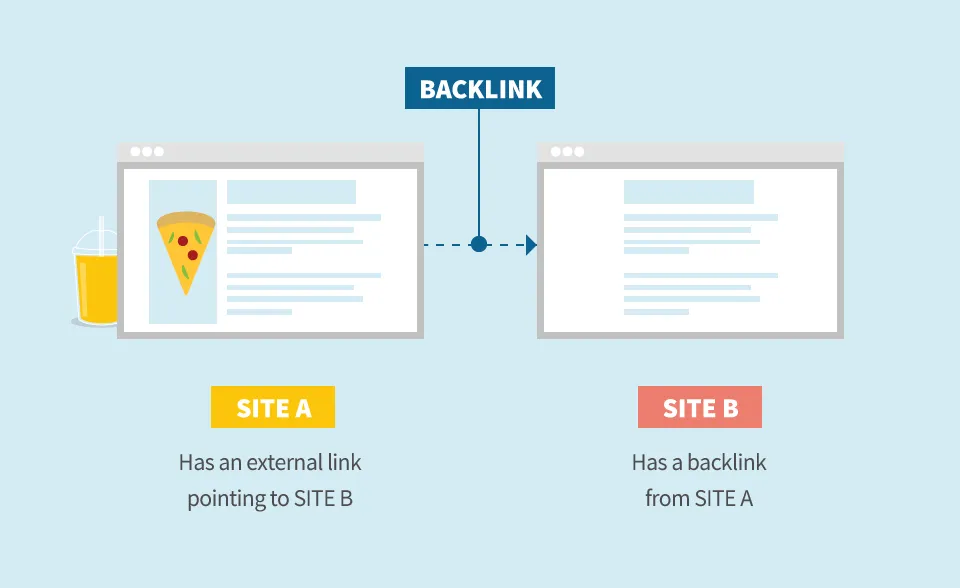
Backlinks also help Google to crawl the internet. The search engines crawlers and bots will use links to move from one website to another, finding new and updated content to index.
When a website links to another, that link passes link equity or link juice. Depending on how authoritative the original linking page is, it will pass some of its authority to the webpage it's linking to.
Get a FREE trial of the SEMRush Backlink Tool.
Google's PageRank algorithm helps it assess the quality of backlinks pointing to a web page, thus helping Google rank the web page in search results. Three key factors impact the PageRank that Google gives a web page:
- The number of backlinks a web page has pointed to it.
- The number of links on the original linking page (the "link juice" of that page will be distributed amongst all of the links it features).
- The PageRank of the original linking page.
The different types of links
There are a few different types of links that you'll need to get your head around if you want to start building up a solid backlink profile for your website.
Internal link - An internal link is a link from one webpage on the same domain to another. This is when you link from one of your web pages to another.
External link - An external link is a link from your website to another external website.
Nofollow link - Nofollow links don't pass any authority from one web page to another. A piece of code, rel=" nofollow", is added to the HTML of a link, which stops any authority from being passed between websites. Whilst Nofollow links don't give power; they still have other benefits such as directing traffic to your website and adding diversity to your backlink profile.
Nofollow links can be used in various ways, including in comments to stop link spam and in affiliate and sponsored posts when you don't want to risk violating Google's rules on buying backlinks (more on that later).
Standard link - A standard link, sometimes known as a dofollow or follow link, is a link to another web page that does pass authority or "link juice" to the page it's linking to.
How to build links for SEO (properly)
Your link profile is all of the links that point to your website. The better your link profile, the more authoritative your website will be deemed to be, and the better Google will rank it in search results.
Your link profile should be made up of several high-quality backlinks. It's important to not sacrifice the quality of your link profile just for the quantity. Google will judge the quality of the links pointing to your website, and if they all appear spammy or low-quality, it will impact your overall SEO strategy.
Below is an image of link data in SEMRush from a site that's continually building its link profile.
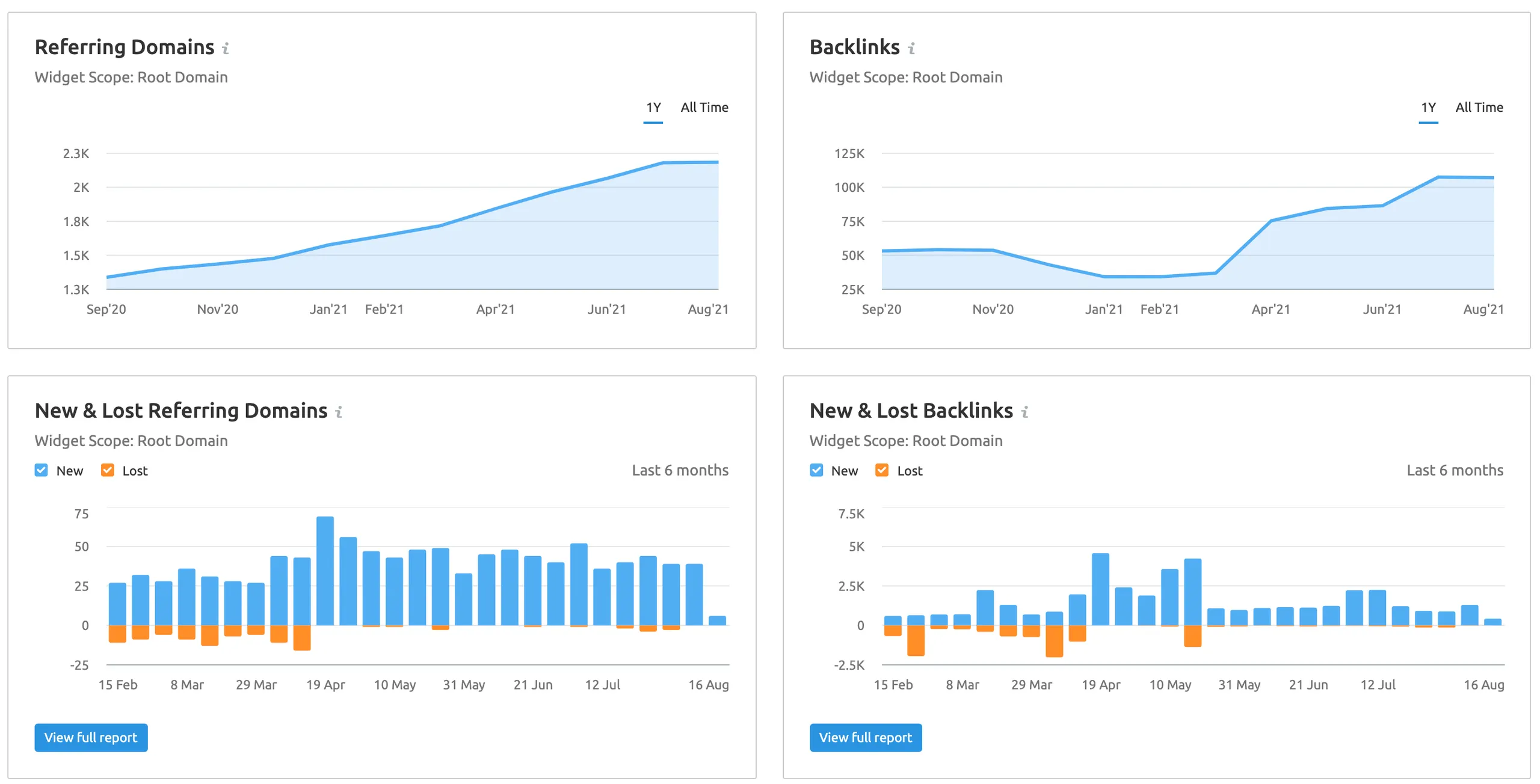
Google also looks for a diverse link profile. It would be best to build up links from a number of different websites, with different PageRanks, and a mixture of standard and nofollow links using various relevant and natural anchor texts.
What is anchor text?
Anchor text is the part of the link that appears in the content. It's the visible, clickable part that will direct users to the new page.
Anchor text helps tell both users and Google's crawlers what the content on the linked page is about. This allows users to decide if they want to follow the link and visit the web page and helps Google's crawlers to judge how relevant the content on the page is.
Below is a snapshot of an anchor text profile for a company
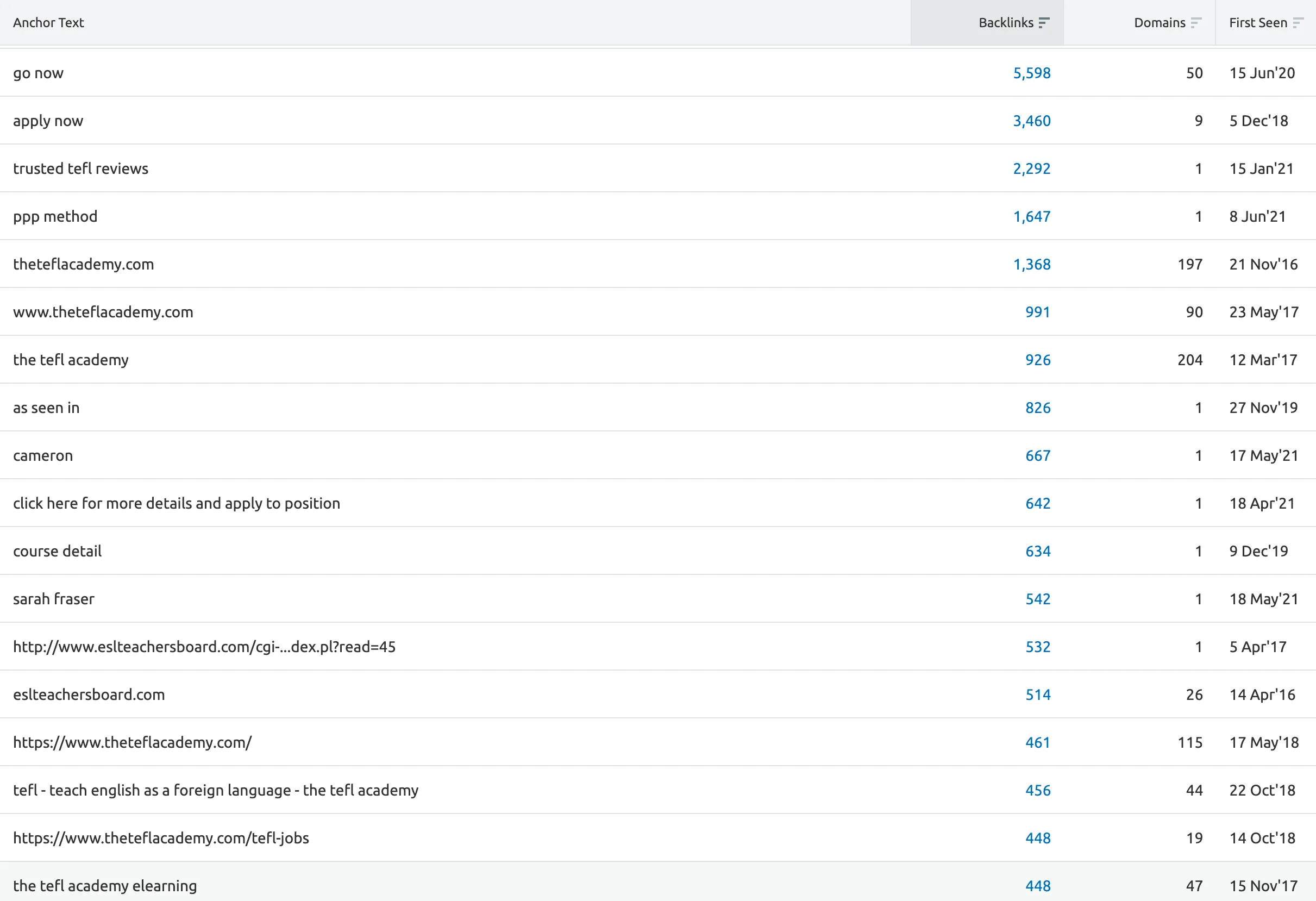
There are various types of anchor text which you can use when linking to other websites and building your backlink profile.
- Generic - This is usually a call to action and relies on surrounding text to provide context for the content on the linked page, such as "click here" or "read more".
- Branded - Branded anchor texts include the brand name of the page you are linking to, e.g. "Amazon".
- Exact match - Exact match anchor text is when the anchor text for the link is the same keyword that the linked page is targeting, for example, "camping equipment".
- Partial match - This is where the anchor text contains the target keyword along with other words, e.g. "best place to buy camping equipment".
- Related - This is when the anchor text uses a variation of the target keyword, for instance, "waterproof tents and sleeping bags" when targeting "camping equipment".
- Naked URL - Instead of using a keyword or phrase, sometimes the anchor text will simply be the URL of the page it links to.
- Brand & Keyword - This is when the anchor text uses both the brand and the target keyword, for example, "Camping equipment Amazon".
- Long-tail - These are similar to partial match anchor texts; however, they are longer, e.g. "the best places to buy waterproof camping equipment in the UK".
The more links you have pointing to your webpage that features an anchor text relevant to your content and the keyword you're targeting, the more likely it is that you'll rank well for that term. Don't be tempted to stuff all of the anchor texts that point to your web page with keywords, though. Google will notice and penalise you accordingly.
Different Link building strategies
So now you know why backlinks are so important, how can you build them? Backlinks are a tricky SEO feature; they have some of the most significant impacts on your rankings, yet they're not something you have that much control over. After all, you can't force another website to link to yours. There are, however, a few different strategies you can implement to help build up your backlink profile.
Guest posting - One of the most popular link building strategies is guest posting on other websites. Guest posting is the process of producing content for another website in the form of a guest post. You will be credited as the author of the content, including a link to your website. Guest posting is mutually beneficial as the website you're writing forgets a free piece of content, and you get a backlink to your site. Everyone's a winner.
Guest posting is also particularly good as it allows you to control the link and anchor text the content features. You can ensure the piece links to the page you want it to using the anchor text to best benefit your SEO strategy.
Finding websites that will accept guest posts, however, can be tricky. The best option is to Google your niche (e.g. SEO) plus phrases such as "write for us" and "submit a guest post". If Google is doing its job correctly, it will hopefully bring up results of websites that create content around your niche, in this case, SEO and who accept guest posts.
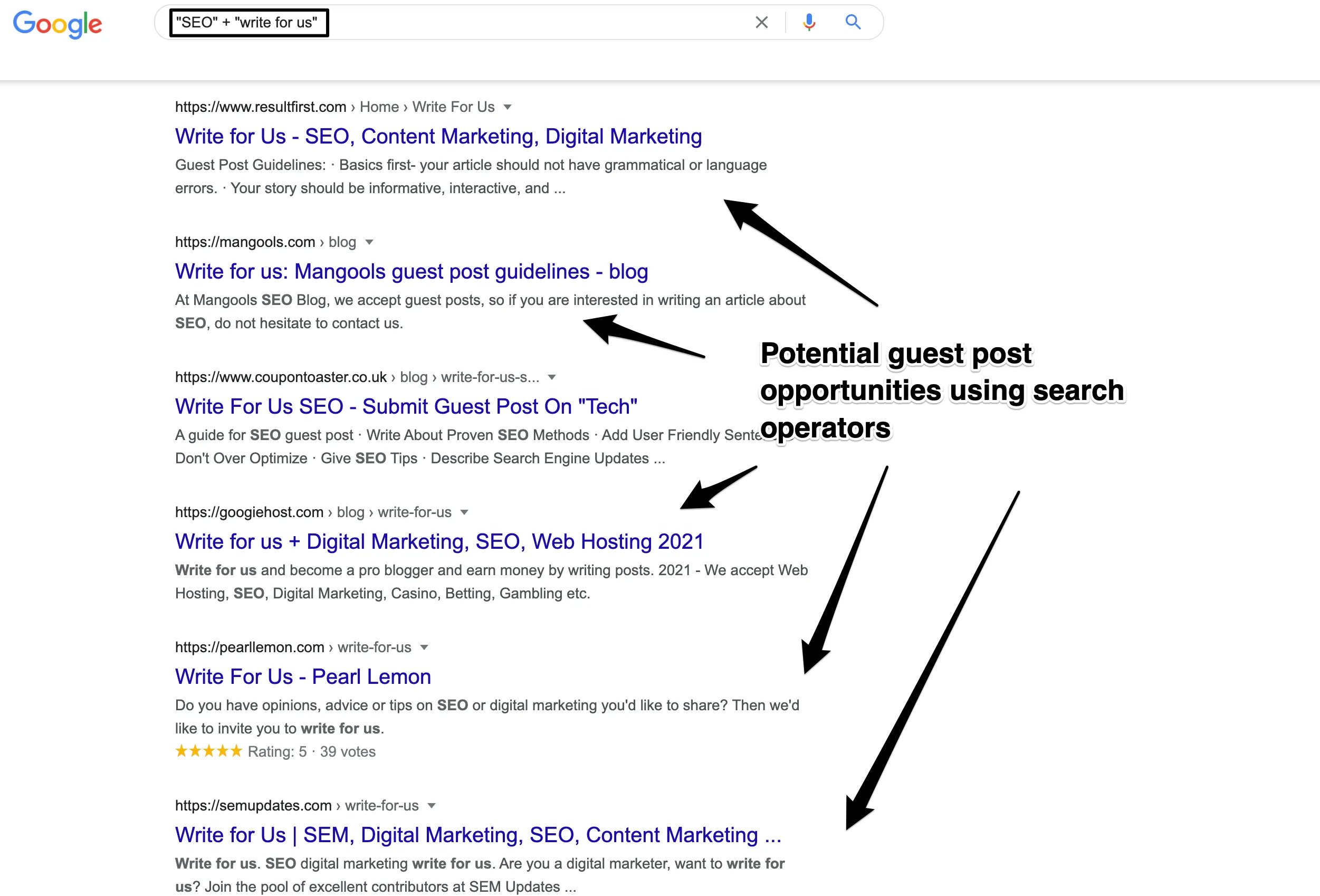
Often websites that accept guest posts will have lists of criteria for the posts they accept. This can include anything from word counts to the tone of voice, post format and image sourcing. It would be best if you were willing to meet all of their criteria to stand a chance of your guest post being accepted.
Create linkable assets - Creating content that people want to link to is the most natural way to build up your backlink profile. If you have content on your website that's informative, high-quality and unique, then people are more likely to link to it from their website.
Although technically, any kind of content could be linkable, providing it's relevant, try to think outside the box and create content that isn't already out there. People will be much more likely to link to something that stands out from the crowd rather than a piece of content that's already been done 100 times over.
Particularly linkable content includes:
- eBooks and infographics (I particularly love this infographic on the Global Carbon Budget)
- Downloadable guides
- Extensive guides that cover a topic in detail (like this very SEO guide!)
- Content that includes unique insights or data
Once you've created your content, make sure to keep sharing it on social media and in your email marketing and send it directly to key industry contacts and websites that you think would be interested in linking to it. How can you expect anyone to link to your content if they don't know it exists?!
Check out your competitors - Taking a look at your competitor's backlink profile is always a good idea. You can use backlink analysis tools that will tell you all of the pages linking to your chosen competitor. You can then go through the list and see if you think any would be willing to link to you as well or even instead.
Run a free backlink audit on your competitors
This is where it comes in handy to have already created high-quality, linkable content. By making sure it's better than what your competitors are creating, you can send it to your target websites and ask if they would be willing to link to your content instead. After all, if you don't ask, you don't get!
Broken link building - This one can take a little more time and effort but can be highly effective at building quality backlinks. Broken link building involves finding a relevant broken link on a website (aka a link that points to a page that the user can no longer access), creating content similar to the original resource the link was pointing to and then asking the post author to swap out their broken link for a link to your content instead. Nobody wants broken links on their website, so often, people will be happy to switch out the links, providing your content is relevant and of the highest quality.
Remember, once you've started to build up an extensive and quality backlink profile, you can begin distributing some of the "link juice" your pages are gaining. If you've managed to get high authority backlinks to one of your pages, it makes sense to add some internal links from this page to help boost some of your other, relevant content too.
Link building strategies to avoid for SEO
Whilst link building can be one of the most beneficial aspects of your SEO strategy; it's certainly not without risk. Building bad backlinks or using dodgy tactics that try to con Google's algorithms can end up causing more harm than good to your search rankings.
So what should you aim to avoid when it comes to building up your backlink profile?
Buying links - Google couldn't be more transparent on its stance about paying for links. Don't. Buying backlinks breaches Google's guidelines and, as such, is what we call a "black hat" SEO tactic.
It can be easy to see why buying links can be so appealing. It's a quick way to build up tens of hundreds of links to your website with minimum effort required. However, if Google figures out what you're up to and realises that you're buying links, the consequences for your website can be enormous.
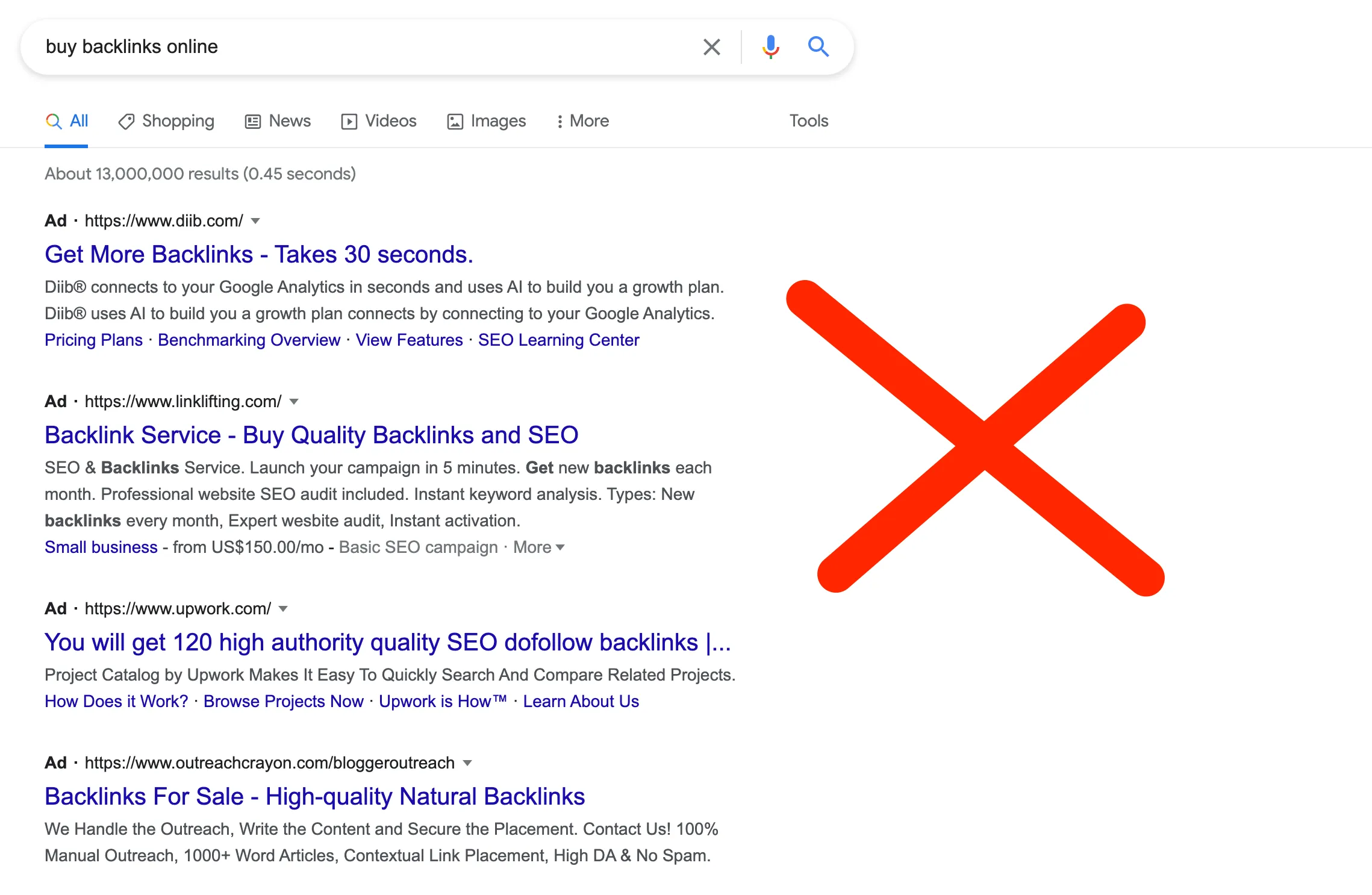
Most websites that are penalised by Google will lose their place in the rankings for all and any keyword for six months or more. Many websites never fully recover their ranking positions after they've been penalised by Google, suggesting even one penalty is enough to mark you forever.
Google views backlinks as a green light for your website. If a website is linking to you, it's endorsing your content; therefore, if Google thinks you've bought the link, it can no longer trust that endorsement.
There are ways around Google's stance on buying backlinks; after all, paying for a handful of high-quality links can have a significant impact on your rankings. It's crucial to balance the potential outcome against the risks before you make a decision.
Directory links - Directories are almost like online Yellow Pages, featuring lists of links to various websites and web pages. They will often be broken down into categories and will transfer "link juice" to the pages they're linking to.
Back in the early days of SEO (god, I'm old!), experts and webmasters cottoned on to how beneficial directories could be and started setting them up for the sole purpose of providing backlinks to websites rather than focusing on the end-users needs.
However, thanks to Google's algorithm updates, the search engine soon got savvy to directories, and now spammy link directories are considered another black hat tactic. Websites with backlinks from dodgy directories will find themselves penalised by Google, so make sure you avoid these at all costs.
Blog comments - Blog commenting was once one of the most used link building tactics. It requires you to comment on blog posts on other websites and include a link back to your website.
Once upon a time, webmasters and bloggers would spend hours commenting on blog posts with comments such as "check out my content here: [link] "... you can see how you'd quickly become annoyed if you were the owner of the blog. Therefore many websites will have made any blog comment links no-follow, meaning they'll pass no authority over to the linked web page.
Google also pretty much always ignores links in blog comments meaning they'll have zero impact on your search rankings and will instead take up a lot of time and effort for no results.
The difference between a good backlink and a bad one
Not all backlinks are equal, nor will they all offer your website the same value. With that in mind, you must think carefully about the type of link you're building. It would be best if you were aiming for good quality backlinks as opposed to bad ones. So what's the difference?
Characteristics of a good backlink
Relevant - Backlinks should always be relevant and should come from websites and web pages where the content is similar to the page on your website that the link is directed to.
For example, if your page features information about buying property and you have one link from an estate agents website and another link from a fashion website, the estate agents link will offer you more value.
When building links, it's essential to consider the content on the website where the link will be placed and not just the "link juice" they can pass to you.
Authority - The more authoritative the linking page is the more value or "link juice" the link will pass to your web page. Two of the primary metrics to note when it comes to determining the web pages that make up your backlink profile are Domain Authority and PageRank.
Page position - A backlink placed near the top of a page or at the beginning of a piece of content is often much more valuable than one that appears at the end. This is down to two reasons; firstly, users are much more likely to click through to a new link that appears closer to the start than they are one at the end, not least because there's no guarantee they'll even get far enough to see the link before they've moved on.
Secondly, Google gives more weight to links that are placed in a prominent position on the page (e.g. at the start of the content) as well as estimating the probability that someone will click on the link to determine the amount of PageRank that the link will pass.
Unique - A backlink from a website that has never linked to you before is often more valuable than a link from one that has. Depending on the websites' quality, it is usually better to have ten links from ten different websites than having twenty links all from the same one.
If you have two backlinks pointing to your website from the same web page, Google will usually value the first link more.
Anchor text - The anchor text of the link can play a part in how valuable it is. Backlinks that feature an anchor text relevant to the content the link is pointing to are often more valuable than links with irrelevant anchor text. Google will also pay attention to the context surrounding the link to understand the context fully.
Characteristics of a bad backlink
Spammy websites - Links from a spammy website will likely do your SEO more harm than good. While it's hard to precisely define what we mean by a spammy website, you can generally determine them as any website you wouldn't want to be associated with your business.
Irrelevant links from spammy websites such as poker or pharmaceutical sites could end up not only impacting your SEO but also tarnishing your brand's reputation. If you start receiving multiple backlinks from these kinds of sites, Google will undoubtedly penalise you, even if you've had absolutely nothing to do with building them.
You can use a backlink tool to assess all of the links you have pointing to your site, and whilst one or two spammy links are unlikely to have too much impact, if you notice multiple backlinks that are a cause for concern, you can use the disavow tool in Google Search Console to request the removal of the link.
Press releases - Some brands will use their PR strategy to help build their backlink profile by filling press releases with links to their website in the hope that news sites will upload the releases, creating multiple new backlinks.
Whilst one or two links in a press release can be a savvy way of directing traffic to your website, Google has previously announced that they don't like press releases that are full of backlinks, and when created, these links will provide considerably less value.
SEO is a long game, and you need to be patient. Sending out press release after press release full of backlinks in the hope that they'll be uploaded to news sites and boost your backlink profile isn't going to cut it.
Irrelevant - Irrelevant backlinks can start to confuse both users and search engines. If you have multiple backlinks pointing to your web page from websites that have nothing to do with your industry or using an anchor text that is irrelevant to the content, then you're going to confuse Google. The search engines crawlers and bots will find it harder to understand what the content on your page is about, and you may find that your web page begins to fall in the rankings for the keywords you're actually targeting.
Whilst you can't always control who links to your website, one thing you can do is ensure that all of the content you create is relevant to your brand. That way, you reduce the chance of a completely unrelated website linking to a piece of your content.
Low domain trust score - A domain trust score is calculated by judging the quality of the backlinks that point to a website. If a website with a low domain trust score, aka one with spammy links pointing to it, links to your website, this can impact your website's SEO and trust score.
If Google sees that a website that has potentially used dodgy link building tactics to boost its backlink profile has linked to your website, the search engine won't place any value on the link it's directing to your web page.
Link schemes/Link mills - A link scheme is where a website has received a link in return for money or other resources. If Google thinks you have built up multiple, low-quality links by using a link scheme, then you'll be penalised.
Google has honed its algorithm over many years to ensure people can't manipulate it. The search engine wants to ensure that the very best content gets the top ranking position and not just the website that has bought the most backlinks.
Whilst there's no doubt that Google takes a harsh view on anyone or anything that tries to manipulate its algorithm, that doesn't mean you shouldn't work on a link building strategy that's natural and relevant.
The most important thing to remember when building up your backlink profile is that you need your links to be relevant and high-quality. Also, try not to build too many links at any one time; you don't want Google to mistakenly think you've gone on a mad link buying spree.
There will always be plenty of people and "experts" who will claim to offer you tens of hundreds of backlinks for a fee but make sure you complete your due diligence and don't be fooled into paying for low-quality backlinks, which could, at best, impact your broader SEO strategy and at worst, result in being penalised by Google which may be almost impossible to come back from.



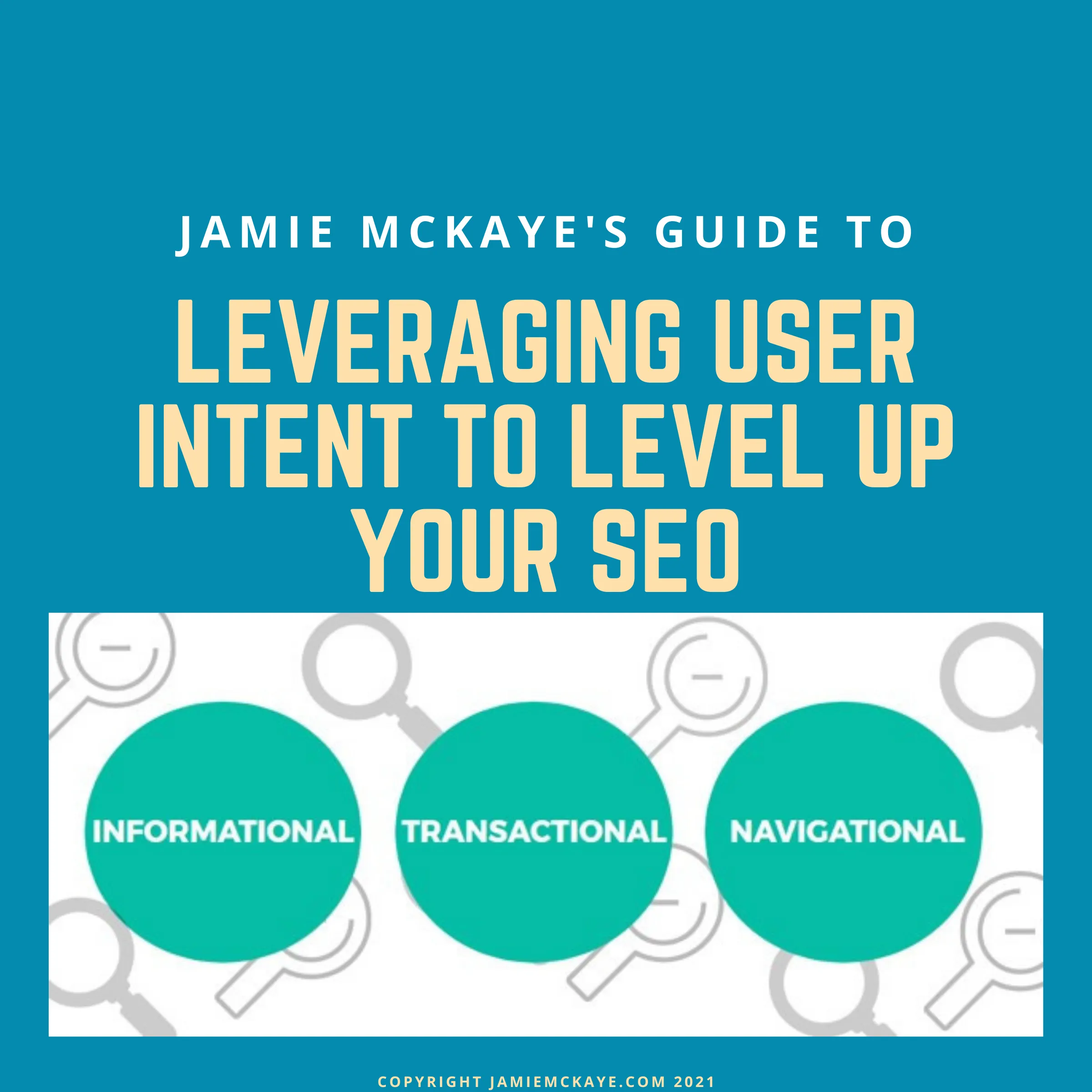

Comments